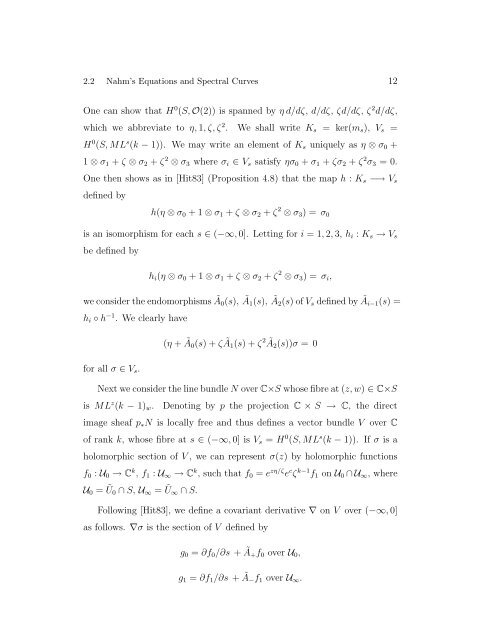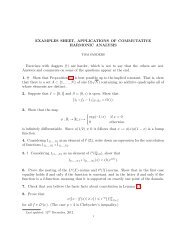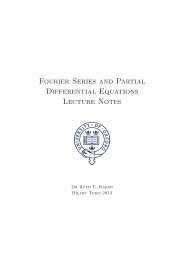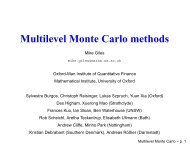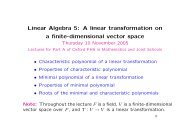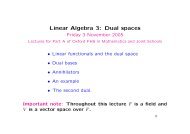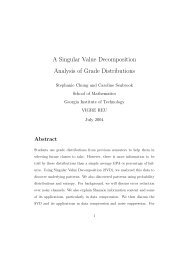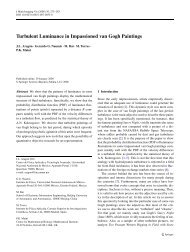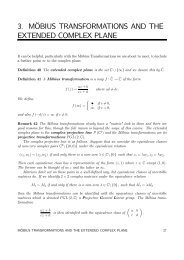Construction of Hyperkähler Metrics for Complex Adjoint Orbits
Construction of Hyperkähler Metrics for Complex Adjoint Orbits
Construction of Hyperkähler Metrics for Complex Adjoint Orbits
You also want an ePaper? Increase the reach of your titles
YUMPU automatically turns print PDFs into web optimized ePapers that Google loves.
2.2 Nahm’s Equations and Spectral Curves 12<br />
One can show that H 0 (S, O(2)) is spanned by η d/dζ, d/dζ, ζd/dζ, ζ 2 d/dζ,<br />
which we abbreviate to η, 1, ζ, ζ 2 . We shall write Ks = ker(ms), Vs =<br />
H 0 (S, ML s (k − 1)). We may write an element <strong>of</strong> Ks uniquely as η ⊗ σ0 +<br />
1 ⊗ σ1 + ζ ⊗ σ2 + ζ 2 ⊗ σ3 where σi ∈ Vs satisfy ησ0 + σ1 + ζσ2 + ζ 2 σ3 = 0.<br />
One then shows as in [Hit83] (Proposition 4.8) that the map h : Ks −→ Vs<br />
defined by<br />
h(η ⊗ σ0 + 1 ⊗ σ1 + ζ ⊗ σ2 + ζ 2 ⊗ σ3) = σ0<br />
is an isomorphism <strong>for</strong> each s ∈ (−∞, 0]. Letting <strong>for</strong> i = 1, 2, 3, hi : Ks → Vs<br />
be defined by<br />
hi(η ⊗ σ0 + 1 ⊗ σ1 + ζ ⊗ σ2 + ζ 2 ⊗ σ3) = σi,<br />
we consider the endomorphisms Ã0(s), Ã1(s), Ã2(s) <strong>of</strong> Vs defined by Ãi−1(s) =<br />
hi ◦ h −1 . We clearly have<br />
<strong>for</strong> all σ ∈ Vs.<br />
(η + Ã0(s) + ζ Ã1(s) + ζ 2 Ã2(s))σ = 0<br />
Next we consider the line bundle N over C×S whose fibre at (z, w) ∈ C×S<br />
is ML z (k − 1)w. Denoting by p the projection C × S → C, the direct<br />
image sheaf p∗N is locally free and thus defines a vector bundle V over C<br />
<strong>of</strong> rank k, whose fibre at s ∈ (−∞, 0] is Vs = H 0 (S, ML s (k − 1)). If σ is a<br />
holomorphic section <strong>of</strong> V , we can represent σ(z) by holomorphic functions<br />
f0 : U0 → C k , f1 : U∞ → C k , such that f0 = e zη/ζ e c ζ k−1 f1 on U0 ∩ U∞, where<br />
U0 = Ũ0 ∩ S, U∞ = Ũ∞ ∩ S.<br />
Following [Hit83], we define a covariant derivative ∇ on V over (−∞, 0]<br />
as follows. ∇σ is the section <strong>of</strong> V defined by<br />
g0 = ∂f0/∂s + Ã+f0 over U0,<br />
g1 = ∂f1/∂s + Ã−f1 over U∞.


